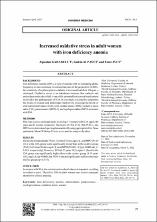| dc.contributor.author | Karabulut, Alpaslan | |
| dc.contributor.author | Alp Avcı, Gülçin | |
| dc.contributor.author | Avcı, Emre | |
| dc.date.accessioned | 2023-02-22T10:58:46Z | |
| dc.date.available | 2023-02-22T10:58:46Z | |
| dc.date.issued | 2022 | en_US |
| dc.identifier.citation | Karabulut, A., Alp Avcı, G., & Avcı, E. (2022). Increased oxidative stress in adult women with iron deficiency anemia. Universa Medicina, 41(1), 29-36. | en_US |
| dc.identifier.issn | 1907-3062 | |
| dc.identifier.issn | 2407-2230 | |
| dc.identifier.uri | http://dx.doi.org/10.18051/UnivMed.2022.v41.29-36 | |
| dc.identifier.uri | https://hdl.handle.net/11491/8454 | |
| dc.description.abstract | BACKGROUND Iron deficiency anemia (IDA), a type of anemia with an increasing global frequency, is more common in women than men in the population. In IDA, the sensitivity of erythrocytes to oxidants is increased and their lifespan is shortened. Oxidative stress is an imbalance between free radicals and antioxidant molecules which is one of the potential biochemical mechanisms involved in the pathogenesis of IDA. In our study, we aimed to determine the levels of oxidant and antioxidant markers by assessing the levels of total antioxidant status (TAS), total oxidant status (TOS), oxidative stress index (OSI), paraoxonase-1 (PON-1), and myeloperoxidase (MPO) in women with IDA. METHODS This was a cross-sectional study involving 47 women with IDA aged 40 years and 47 women volunteers. The levels of TAS, TOS, OSI, PON-1, and MPO were determined spectrophotometrically using appropriate kits. Nonparametric Mann Whitney-U tests were used to analyze the data. RESULTS The levels of antioxidants TAS (1.42 mmol Trolox equiv./L) and MPO (54.00 U/L) in the IDA group were significantly lower than in the control group [TAS (1.67 mmol Trolox equiv./L) and MPO (89.00 U/L)] (p=0.000 and p= 0.019, respectively). However, TOS (6.25 μmol H2O2 equiv./L) level in the IDA group was significantly higher than in the control group (4.13 μmol H2O2 equiv./L) (p=0.000), but PON-1 was not significantly different between the two groups (p=0.375). CONCLUSION In women with IDA, the oxidant-antioxidant balance is impaired, resulting in oxidative stress. Therefore, IDA in adult women must receive adequate attention in clinical practice. | en_US |
| dc.language.iso | eng | en_US |
| dc.publisher | TRISAKTI UNIV, FAC MEDICINE | en_US |
| dc.relation.ispartof | UNIVERSA MEDICINA | en_US |
| dc.rights | info:eu-repo/semantics/openAccess | en_US |
| dc.rights | Attribution-NonCommercial-ShareAlike 4.0 International (CC BY-NC-SA 4.0) | * |
| dc.rights.uri | https://creativecommons.org/licenses/by-nc-sa/4.0/ | * |
| dc.subject | Iron deficiency anemia | en_US |
| dc.subject | Antioxidants | en_US |
| dc.subject | Paraoxonase-1 | en_US |
| dc.subject | Myeloperoxidase | en_US |
| dc.subject | Oxidative stress | en_US |
| dc.subject | Women | en_US |
| dc.title | Increased oxidative stress in adult women with iron deficiency anemia | en_US |
| dc.type | article | en_US |
| dc.department | Hitit Üniversitesi, Tıp Fakültesi, Dahili Tıp Bilimleri Bölümü | en_US |
| dc.identifier.volume | 41 | en_US |
| dc.identifier.issue | 1 | en_US |
| dc.identifier.startpage | 29 | en_US |
| dc.identifier.endpage | 36 | en_US |
| dc.relation.publicationcategory | Makale - Uluslararası Hakemli Dergi - Kurum Öğretim Elemanı | en_US |
| dc.identifier.doi | 10.18051/UnivMed.2022.v41.29-36 | en_US |
| dc.description.wospublicationid | WOS:000767863400001 | en_US |




















